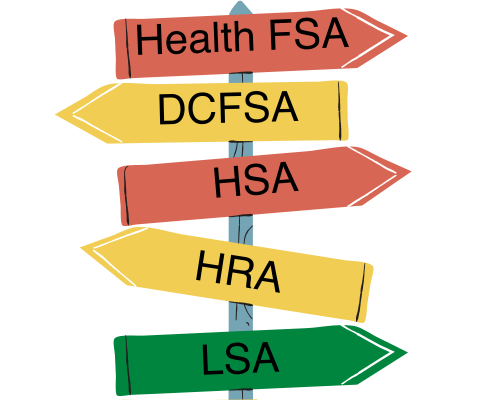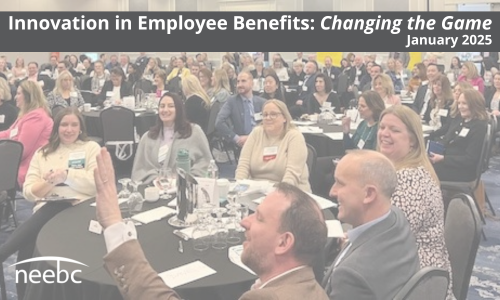 Even the most seasoned HR or benefits professional can get lost in the alphabet soup that is the world of spending accounts. Between FSAs, HRAs, and HSAs alone there are countless rules and plan options that can escape those who don’t interact with these accounts for a living. Add to that the recent introduction of the LSA (Lifestyle Spending Accounts) and the confusion only grows.
Even the most seasoned HR or benefits professional can get lost in the alphabet soup that is the world of spending accounts. Between FSAs, HRAs, and HSAs alone there are countless rules and plan options that can escape those who don’t interact with these accounts for a living. Add to that the recent introduction of the LSA (Lifestyle Spending Accounts) and the confusion only grows.
Below is a concise overview of the five account types we’re asked about most often by employers trying to improve the financial wellbeing of their workforce, followed by a brief update on how the One Big Beautiful Bill Act affected Dependent Care FSAs and HSAs.


 As benefits leaders consider 2026 renewals and plan ahead for their 2027 strategies, new opportunities are emerging in how organizations approach musculoskeletal (MSK) care. While traditional Centers of Excellence (COE) have focused on surgical interventions, a new approach, non-operative COEs, prioritize conservative treatment and early intervention over surgical treatment. This shift represents a strategic response to mounting cost pressures driven by inappropriate utilization of surgery, and recognizes that many MSK conditions can be effectively managed without surgery.
As benefits leaders consider 2026 renewals and plan ahead for their 2027 strategies, new opportunities are emerging in how organizations approach musculoskeletal (MSK) care. While traditional Centers of Excellence (COE) have focused on surgical interventions, a new approach, non-operative COEs, prioritize conservative treatment and early intervention over surgical treatment. This shift represents a strategic response to mounting cost pressures driven by inappropriate utilization of surgery, and recognizes that many MSK conditions can be effectively managed without surgery. As we honor National Caregiver Month this November, it’s time to recognize that caregiving is no longer a peripheral issue—it’s a central force shaping workforce dynamics, employee well-being, and organizational resilience. For over 35 years, the Boston College Center for Work & Family (BCCWF) has driven progress on critical work-life issues related to caregiving, emphasizing the importance of flexible work, paid leave for parents and caregivers of all types, and promoting men as equal caregivers. From our recent conversations with work-life practitioners and thought leaders, it is clear that employers are looking for ways to better understand the care demographics of their workforces and the invisible loads they carry, and respond with supports that make a difference.
As we honor National Caregiver Month this November, it’s time to recognize that caregiving is no longer a peripheral issue—it’s a central force shaping workforce dynamics, employee well-being, and organizational resilience. For over 35 years, the Boston College Center for Work & Family (BCCWF) has driven progress on critical work-life issues related to caregiving, emphasizing the importance of flexible work, paid leave for parents and caregivers of all types, and promoting men as equal caregivers. From our recent conversations with work-life practitioners and thought leaders, it is clear that employers are looking for ways to better understand the care demographics of their workforces and the invisible loads they carry, and respond with supports that make a difference. Menopause is a natural transition that affects nearly all women. The more we learn about this life change, the more we understand how much it impacts people’s personal and professional lives. Based on recent research, companies must understand menopause better to improve the health of their employees and the bottom line.
Menopause is a natural transition that affects nearly all women. The more we learn about this life change, the more we understand how much it impacts people’s personal and professional lives. Based on recent research, companies must understand menopause better to improve the health of their employees and the bottom line. Primary care physicians and advanced practice professionals provide a gateway to better health. They enable and direct preventive care, which in turn plays a significant role in helping people avoid chronic diseases, reducing overall health care costs.
Primary care physicians and advanced practice professionals provide a gateway to better health. They enable and direct preventive care, which in turn plays a significant role in helping people avoid chronic diseases, reducing overall health care costs. Employers seeking to mitigate risk and manage rising healthcare costs should be mindful of the need to strengthen their social contract with their workforce. That’s going to make it critical to step up their game with
Employers seeking to mitigate risk and manage rising healthcare costs should be mindful of the need to strengthen their social contract with their workforce. That’s going to make it critical to step up their game with  In today’s complex world of work, employee wellbeing has become more than a buzzword—it’s a critical pillar of sustainable business performance. Yet, approaches to wellbeing vary significantly across countries, shaped by cultural norms, government policy, and societal expectations. From Scandinavia’s flexible work structures to Japan’s growing mindfulness culture, global perspectives offer valuable lessons for organizations looking to create more inclusive and effective wellbeing strategies (globally or domestically).
In today’s complex world of work, employee wellbeing has become more than a buzzword—it’s a critical pillar of sustainable business performance. Yet, approaches to wellbeing vary significantly across countries, shaped by cultural norms, government policy, and societal expectations. From Scandinavia’s flexible work structures to Japan’s growing mindfulness culture, global perspectives offer valuable lessons for organizations looking to create more inclusive and effective wellbeing strategies (globally or domestically). Technology is transforming health care with enhanced data insights, personalized solutions, and simpler tools that help members achieve their health ambitions.
Technology is transforming health care with enhanced data insights, personalized solutions, and simpler tools that help members achieve their health ambitions. Pelvic floor pain for women can be caused by many factors. Your employees or their family members shouldn’t have to suffer alone. Learn about the different treatment options and expert recommendations that you can share with your workforce and their loved ones.
Pelvic floor pain for women can be caused by many factors. Your employees or their family members shouldn’t have to suffer alone. Learn about the different treatment options and expert recommendations that you can share with your workforce and their loved ones.  For a third consecutive year, The NEEBC community gathered to connect and learn about ever-developing innovations making a difference for the workforce. NEEBC’s January 23
For a third consecutive year, The NEEBC community gathered to connect and learn about ever-developing innovations making a difference for the workforce. NEEBC’s January 23